Rich Investors Eschew Financial Advice, Trade ETFs Frequently
Wealthier people are less likely to value financial advice, but there are consequences to trading ETFs outside of advisory relationships.

Sign up for exclusive news and analysis of the rapidly evolving ETF landscape.
They’re wealthy, they like ETFs, and they are using their own brains for at least some investment decisions rather than leaning on financial advisors.
That’s the case for about 40% of people with $5 million to $10 million in investable assets, new data from consumer-research firm Hearts & Wallets show. People in that group report being confident about investment decision-making — on average, seven times the level of investors across the wealth spectrum. Less than half of those in the affluent group said they see value in financial advice. And increasingly, exchange-traded funds are their vehicle of choice, with 61% of people in the group using them in 2024, up from 46% in 2023 and 39% in 2022. There are about 1.8 million people in the $5 million to $10 million range, and they control a total of over $14 trillion, according to Hearts & Wallets.
“They’re experimenting with things,” said Laura Varas, the firm’s CEO. “Their use of ETFs is just skyrocketing, and they’re trimming back their SMAs.”
Playing Favorites
While the 40% figure seems high, it’s trending downward, Varas said. Five years ago, 59% of people in that asset group said they relied upon themselves as their primary source of investment information. A current red flag, however, is that 30% view artificial intelligence as having a positive impact on financial services, compared with 20% among all investors, she added. The wealthy group is also moving money around frequently between different financial services providers and trading ETFs often, the report found.
Beyond the potential for clients to simply make poor investment choices, trading outside of the advisory relationship can throw their allocations out of whack, said Pamela Chen, founder of Refresh Investments. “Consequently, their overall investment portfolio deviates from the targeted asset allocation and risk profile, leading to unintended risk exposures,” she said. Another issue is taxes. “Many don’t fully understand the ramifications of selling out of a holding that has appreciated, and often the important difference between short-term and long-term gains is overlooked,” said Kristen Vernace, founder of Pathways Financial Planning.
It can be healthy for investors to trade by themselves, but wealthier households might limit that to 5% to 10% of their investable assets and treat it as “play money,” said Jose Alvarez, founding advisor at Harvest Horizon Wealth Strategies. Another advisor, Cynthia Meyer, founder of Real Life Planning, often works with real estate investors who have built considerable wealth. “Many like the idea of portfolio coaching, where they can collaborate with their advisor,” she said. “They don’t want an advisor to tell them to sell their real estate and put it in a brokerage account that benefits the advisor’s AUM.”
As to where the $5 million to $10 million group invests, according to Hearts & Wallets:
- Fidelity, Vanguard and BlackRock/iShares had the biggest share of customers of their ETFs.
- Most often, people were trading through Fidelity, Bank of America/Merrill Lynch and Morgan Stanley/ E*Trade.
It’s all about the price tag: Wealthier investors are keenly aware of what they pay, with just 5% of households last year saying they were unaware of fees, compared with 25% among all customers at the national level. “It’s part of a bigger fee-aversion story,” Varas said. “As they get more ETFs, they’re on self-directed platforms, and they’re making lots of trades.”











